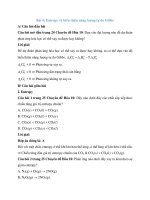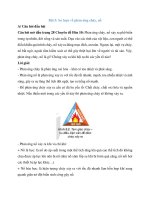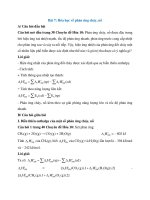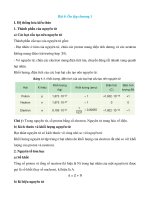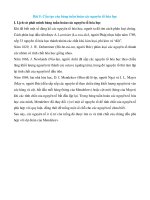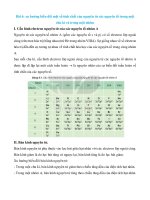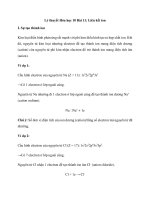Đề thi 20% lý thuyết dịch số 3
Bạn đang xem bản rút gọn của tài liệu. Xem và tải ngay bản đầy đủ của tài liệu tại đây (0 B, 3 trang )
HANOI OPEN UNIVERSITY
MID -TERM TEST ON TRANSLATION THEORIES
FOR STUDENTS OF ENGLISH (No 3)
Subject Code: EN43
Full name: ………………………………...............
Date of birth: ………………………………...........
Group: …………………………………….............
I. Answer the following questions: (40 points)
1. What are Nida's Linguistic Theories of Translating?
2. What are Nida's Sociolinguistic Theories of Translating?
(The file sent will be named after each student’s name. Plagiarism will lead to failure)
Answer:
1.
-
Linguistic theories of translation, according to Nida (1976: 69), are based on a
comparison of the Linguistic structures of the source tranlations and target
translations, rather than a comparison of literary genres and stylistic features of
the philological theories.
-
Thus, ‘Linguistic Translation’ ( or Linguistic Approach ) is a product of these
theories which view translation as simply a question of replacing the linguistic
units of the source text with “equivalent” target languge units without reference
to factors such as context or connotation.
-
According to Nida and Taber (1969:134) it is only a linguistic translation that
can be considered ‘faithful’ , because it “is one which only contains elements
which can be directly derived from the source text wording, avoiding any kind
of explanatory interpolation or cultural adjustment which can be justified on
this basis.”
-
One major difference between linguistic theories of translating and
philological theories of translating is that linguistic theories are descriptive
rather than prescriptive. They demonstrate how people translate rather than
how they should translate.
-
According to Nida (1976): The principal differences between various linguistic
theories (or semi-theories) of translation lie in the extent to which the focus is
on surface structures or corresponding deep structures. Theories based on
1
surface-structure comparisons involve the use of more-or-less elaborate sets of
rules for matching roughly corresponding structures.
2.
Sociolinguistic theories of translating emerged out of the dissatisfaction with
linguistic theories of translating, and the growing interest in communication. Such
interest resulted from the work of anthropologists who recognized the role of text
recipients in the process of translating.
Sociolinguistic theories of translating relate linguistic structures to a higher level
where they can be viewed in terms of their function in communication. When
discussing a text, the sociolinguist is concerned particularly with its author, its
historical background, the circumstances involved in its production, and the history
of its interpretation.
Nida and Taber (1969), have pointed out that the old fucus on the form of the
message in translation has shifted to the receptors, i.e. the readers. Therefore, it is
the reader’s reponse to the translated message that determines the correctness of
the message. They set the average reader as the only criterion for measuring
correctness in translating. Correctness, in the view, is not only the possibility of
understanding the message by readers but rather than the possibility of
misunderstanding it.
II. Translation practice
1. Read the text and find out the features of the situational context (30 points)
... He was a comely handsome fellow, perfectly well made, with straight, strong
limbs, not too large, tall, and well shaped; and as I reckon, about twenty six years of age.
He had a very good countenance, not a fierce and surly aspect, but seemed to have
something very manly in his face; and yet he had all the sweetness and softness of a
European in his countenance, too, especially when he smiled. His hair was long and
black, not curled like wool: his forehead very high and large; and a great vivacity and
sparkling sharpness in his eyes. The colour of his skin was not quite black, but very
fawns. His face was round and plump; his nose small, not flat like the Negroes, a very
good mouth, thin lips, and his fine teeth well set and as white as ivory...
...In a little time I began to speak to him, and teach him to speak to me: and, first, I
let him know his name should be "FRIDAY", which was the day I saved his life. I called
2
him so for the memory of the time.
………………………………………………………………………………………………
Field:
Tenor:
Mode:
2. Translate the text into Vietnamese (30 points)
Anh ta là một anh chàng khơi ngơ tuấn tú, có thân hình hồn hảo, chân tay thẳng tắp,
khỏe, không quá to, cao và dáng chuẩn; và như tôi nghĩ, khoảng hai mươi sáu tuổi. Anh ta
có một khn mặt rất ưa nhìn, khơng phải là một khía cạnh dữ tợn và quái gở, nhưng
dường như có một cái gì đó rất đàn ơng trong khn mặt của anh ta; và anh ta cũng có tất
cả sự ngọt ngào và uyển chuyển của một người châu Âu trên nét mặt , đặc biệt là khi anh
ấy cười. Tóc anh ta dài và đen, khơng quăn như lông cừu: trán rất cao và lớn; và một sự
hoạt bát tuyệt vời và sự sắc nét lấp lánh trong đôi mắt của anh ấy. Màu da của anh ta
không hồn tồn đen, nhưng rất ngớ ngấn. Gương mặt trịn bầu bĩnh; mũi nhỏ, không tẹt
như người da đen, miệng rất ngoan, môi mỏng, răng đều và trắng như ngà.
3
